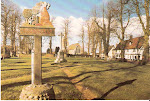In 1733 a ROBERT GILBERT (b. circa 1713) probably came from, we know not where, to marry SARAH ENGLISH (b. circa 1713) in a small village south of Norfolk called BANHAM. Banham is in the triangle of the market towns of Attleborough, Thetford and Diss.
Map showing the position of Banham in relation to Thetford, Attleborough, Wymondham, Norwich and Diss
At that time drovers came from all over England, Wales and Scotland to sell to the Norfolk markets, as did fishermen sailing the east coast. Between the 11th century and the industrial revolution, Norwich was England's second city to London. It is said that the area benefitted from the prosperity which came from the flourishing woollen industry in the16th and 17th centuries. Despite markets being held nearby, Banham had its own weekly market even having an annual fair for horses, toys, etc (still recorded in 1845 as being held on 22nd June).
There are Gilberts in Cornwall, the Midlands, you name it but, usually in the early 1700s, one family, as we find in Banham. So far not a clan that could give us clear links to that 'first' Robert in Banham.
The prevalence of the name Robert in the family, led my grandfather, ALBERT (b.1904), to speculate that our ancesters were originally Scottish, but he also put the black curly hair and engineering traits down to a Cornish link. A Scottish friend of mine pointed out that the name Robert was Norman French and was adopted by mixed Scottish-Norman families in honour of Robert I of Scotland (aka Robert de Brus, aka Robert the Bruce). Adding to this the Norman origins of the name Gilbert we could be looking at Norman French roots. It would be very tidy though if we could be linked with that 13th century ROBERT GYLEBERT of Norfolk mentioned above, this would show that Robert was a long established family name and our ROBERT (b. circa 1713) was not a long distance immigrant.
I visited Banham in 1997 whilst in Norfolk to study the Parish records. At the time the gravestones around the 14th century parish church were removed for cleaning, logging and re-positioning so I couldn't use them as a reference. (This source needs to be followed up). I decided to see if any of the buildings I had found on the tithe maps and parish information were still standing, as the centre of the village was mostly unchanged. I only had a few hours in Banham due to the country bus timetable so just photographed and wrote down what I came across. It wasn't until I got home (and since in writing this up) that I realised what an amazing treasure trove of information I had accumulated in such a short time.



No comments:
Post a Comment